Contents
- What Are ‘Compression Socks’?
- How Do Compression Socks Work?
- What’s the Difference Between Regular Socks and Compression Socks?
- What Should You Know Before Buying Good Compression Socks?
- Top 10 Best Compression Socks for Men 2024
- 1. Best Overall Compression Socks: Physix Gear Sport
- 2. Best Budget Compression Socks: SB SOX
- 3. Best Compression Socks for Running: CHARMKING
- 4. Best for Ankle, Arch and Heel Support: Bitly Plantar Fasciitis
- 5. Best Compression Socks for Travel: Laite Hebe
- 6. Best Premium Compression Socks: FuelMeFoot Copper
- 7. ACTINPUT
- 8. Best for Relief from Swelling: BLITZU
- 9. Iseasoo Copper Knee High
- 10. Vitalsox Silver Drystat Patented Athletic Graduated
- Honorable Mentions
- Frequently Asked Questions
- Benefits of Compression Socks
- Pro Tips for Making the Best Use of Compression Socks
- Final Thoughts
What Are ‘Compression Socks’?
Compression socks are specially designed to fit more snugly than regular socks. They are closely-knitted, super-stretchy, and apply gentle pressure to the wearer’s legs.
Compression socks have been game-changers in helping athletes achieve stellar sporting feats. They’re designed to apply compression therapy to the feet, toes, heels, arches, ankles, calves, and lower legs as people go about performing their daily chores or athletic endeavors.
How Do Compression Socks Work?
Compression socks are specially crafted to protect our limbs and help in enhancing our performance by regulating blood flow from the heart to the legs, avoiding injuries, preventing inflammation and swellings, promoting proper lymphatic drainage, and keeping pain at bay. We’ll cover the science behind this in detail later in the guide.
What’s the Difference Between Regular Socks and Compression Socks?
The key difference between compression socks and regular socks is that compression socks apply more pressure and cocoon our legs more snugly than regular socks. The level of compression applied has been fine-tuned after careful medical research, and there are some standard pressure gradings that all compression socks adhere to.
What Should You Know Before Buying Good Compression Socks?
Before you make your first purchase, you should know what kind of compression socks would best serve your needs. We’ve created a short checklist you can go through before settling on the right kind of compression socks for you.
Uniform vs. Graduated Compression Socks
While some socks provide the same level of compression throughout the length of the socks, others have graduated levels of compression that increase at specific points like the ankles, arches, and decrease at other points like at the toes and as they go further up the leg.
Levels of Compression
There are standard grades of compression for compression socks in the following range:
- 8-15 mmHg – Mild Compression
- 15-20 mmHg – Moderate Compression
- 20-30 mmHg – Firm Compression or Class I Compression
- 30-40 mmHg – Extra Firm Compression or Class II Compression
- 40-50 mmHg – Class III Compression – Requires a prescription
If you’re unsure which compression is right for you, we’ll explore the implications of these grades later in the FAQ section so you can figure out which is best for you.
Textiles Used for Knitting
Cotton, spandex, nylon, wool, natural rubbers, and other suitable fibers are used to knit compression socks with varying levels of compression, elasticity, thickness, softness, texture, and durability. Different textiles and combinations contribute to different properties like nylon and spandex to antibacterial fibers, cotton to breathability, elastane to elasticity, wool to thickness, and so on.
Length of the Socks
Usually, standard-sized compression socks end an inch or two below the knee. People who need knee support might opt for above the knee socks or knee support sleeves while those looking only for ankle support might opt for ankle-length compression socks or ankle sleeves. In addition to these, there are compression sleeves that provide support to specific areas like calves, foot arches, and so on.
Design Specs
Depending on where and how the socks are designed to provide the maximum support and compression, they can cater to different activities like running, compression socks to combat swelling, standing all day and for long-distance travel.
Based on the above criteria, you can decide what length, material, price, level of compression, and the type of compression socks to invest in. Below is a carefully curated list of the top 10 best compression socks for men. It covers a wide range of compression socks at different price points and has something for everyone. Do note that most compression socks are designed to be unisex.
Top 10 Best Compression Socks for Men 2024
1. Best Overall Compression Socks: Physix Gear Sport
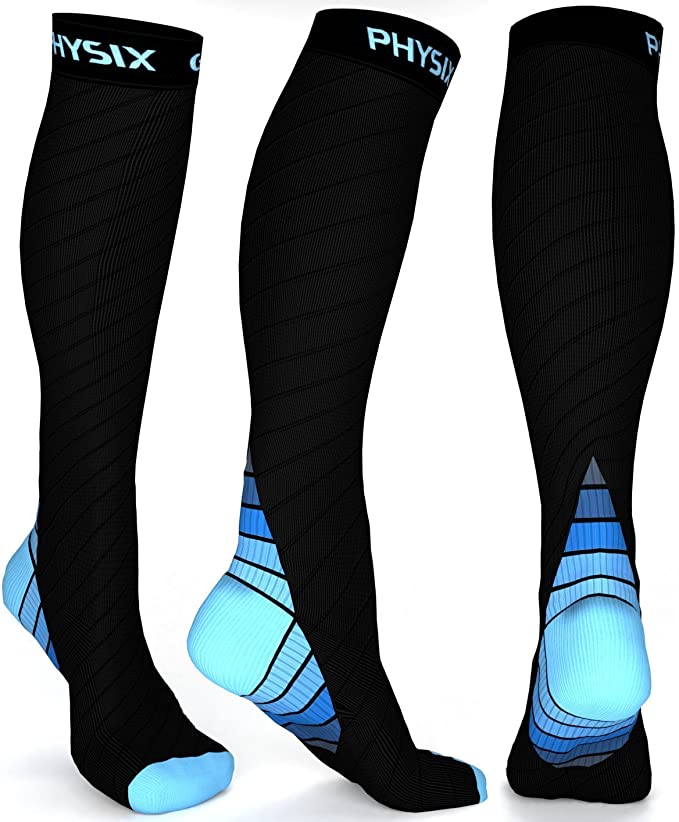
Editor’s Rating:
Quick Facts
Textiles: Spandex and Nylon
Compression Level: 20-30 mmHg, graduated compression socks
Length: Standard
Review
The Physix Gear Sports compression socks for men employ patented technology that’s unique to their brand. The popularity of these socks amongst athletes is a testament to the suitability of this technology to athletic sportswear, not to mention the excellent customer service they provide as a family run business. These socks have double-stitched fabric, even though the design avoids stitches in places where there’s likely to be wear and tear.
You can actually feel the graduated compression, with ample support for heels and arches and reduced pressure on legs and toes. Antibacterial and moisture-wicking technologies keep odor and sweat problems at bay. This design is highly recommended for people who have thicker legs and need light compression socks to deal with inflammatory and fluid retention problems. The socks do not lose their elasticity even after multiple washes, providing good value for money with their durability. The blend of nylon and spandex is also good for those who sweat a lot and want to avoid drenched feet as they workout.
These are the best compression socks for men, especially those who regularly indulge in athletic activities. We have them at the top of our list as they were specifically designed to address all the problems that one encounters in the sports and fitness arenas.
- Lightweight – good for indoors and all-day wear
- Moisture-wicking technology dries socks fast
- Graduated compression allows the toes to breathe
- Antibacterial material keeps odors away
- Specifically designed for athletic pursuits
- Pricey for a single pair of socks
- Longer in length than standard sizes
2. Best Budget Compression Socks: SB SOX
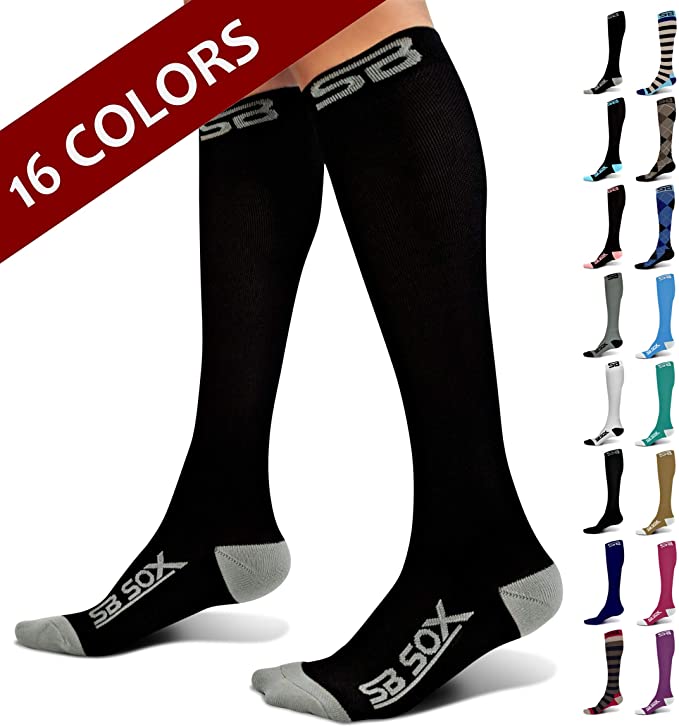
Editor’s Rating:
Quick Facts
Textile: Lightweight premium nylon and spandex
Compression Level: 20-30 mmHg, graduated compression socks
Length: Standard
Review
These firm compression level socks are designed to ensconce your feet and lower legs in their soft warmth like a snug glove. The graduated compression ensures that the band at the top doesn’t cut into your calves but still stays firmly in place, even when you wear these socks for long durations or during rigorous sports activities.
If your job involves being on your feet all day long then these are the best compression socks available. These are as good as medical-grade compression socks, but you can get them without a prescription and they also do not cost the earth.
These socks are thick in composition, with way more nylon than spandex fibers used in the design. As a result, they aren’t super stretchy. They promote proper blood circulation and improve lymphatic drainage which means you won’t have any swelling in your feet at the end of the day, nor will you feel like your legs have turned into tired and heavy bricks.
This also means you can train for longer periods without any discomfort related to your sports gear. If you already have problems with varicose veins, deep vein thrombosis (DVT), or swelling, these are the best compression socks you can buy for yourself.
The only issue seems to be the seam that runs across the toes. It’s a bit bulky sometimes and stands out. It’s good for those who have wide feet or flat feet but a bit problematic for those who have slender feet.
- 16 colors to choose from
- The top band stays in place and never rolls down
- Can be worn for long durations
- Especially good for combating swollen feet
- Thick, warm, and soft to touch
- Problematic seams around the toes
3. Best Compression Socks for Running: CHARMKING
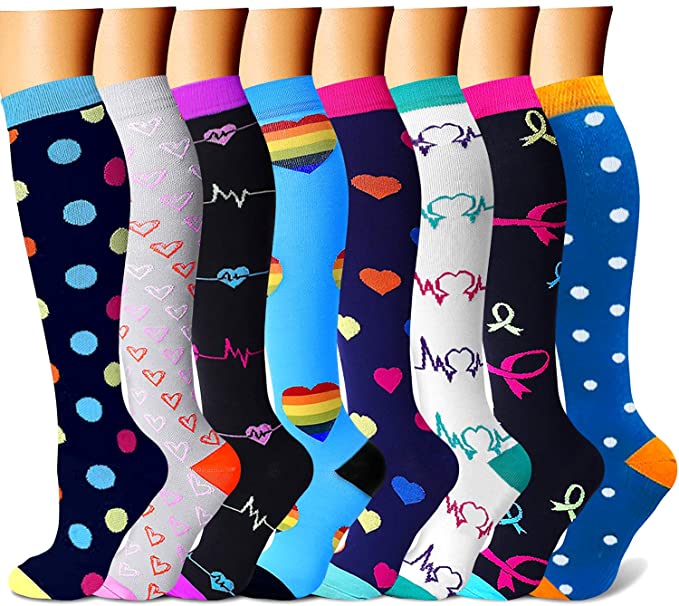
Editor’s Rating:
Quick Facts
Textile: 85% Nylon
Compression Level: 15 – 20 mmHg
Length: Knee-length
Review
These socks are designed to be a fashionable pick for athletes. These aren’t intended to be medical grade socks and hence use low and uniform compression throughout the length of them.
Due to this, it promotes healthy circulation of blood while running, hiking, and performing other physical activities. The nylon and other breathable fabrics used keep the temperature at low levels to avoid excessive sweating and moisture + bacteria build-up.
There’s enough pressure to avoid muscle cramping so you can train for long durations. The dryness, long-duration wearability, low temperature, lightweight, and low compression level of these socks prevent injuries, swelling, fatigue, and enhance your performance.
These are also very affordable as well as stylish and you can choose from a variety of designs and color combinations. You can order the pack of 3 to test them out and if you like them, you can go for the pack of 8. While the former is good for a trial run, the latter gives better value for money as it works out to less than $4 per pair of compression socks, making it one of the most affordable options for compression socks available online.
The top band is a little problematic and might feel too tight initially. The socks aren’t standard sized and run a little large so you might have to order different sizes before you find the perfect fit.
- Fibers keep the temperature low and prevent sweating
- Stay dry for long durations
- Antibacterial
- Low compression for non-medical compression wear
- More than 80 styles and colors to choose from
- One of the cheapest compressions socks in the market
- The band at the top pinches a little sometimes
- Not standard-sized – need a trial to figure out the right fit
4. Best for Ankle, Arch and Heel Support: Bitly Plantar Fasciitis
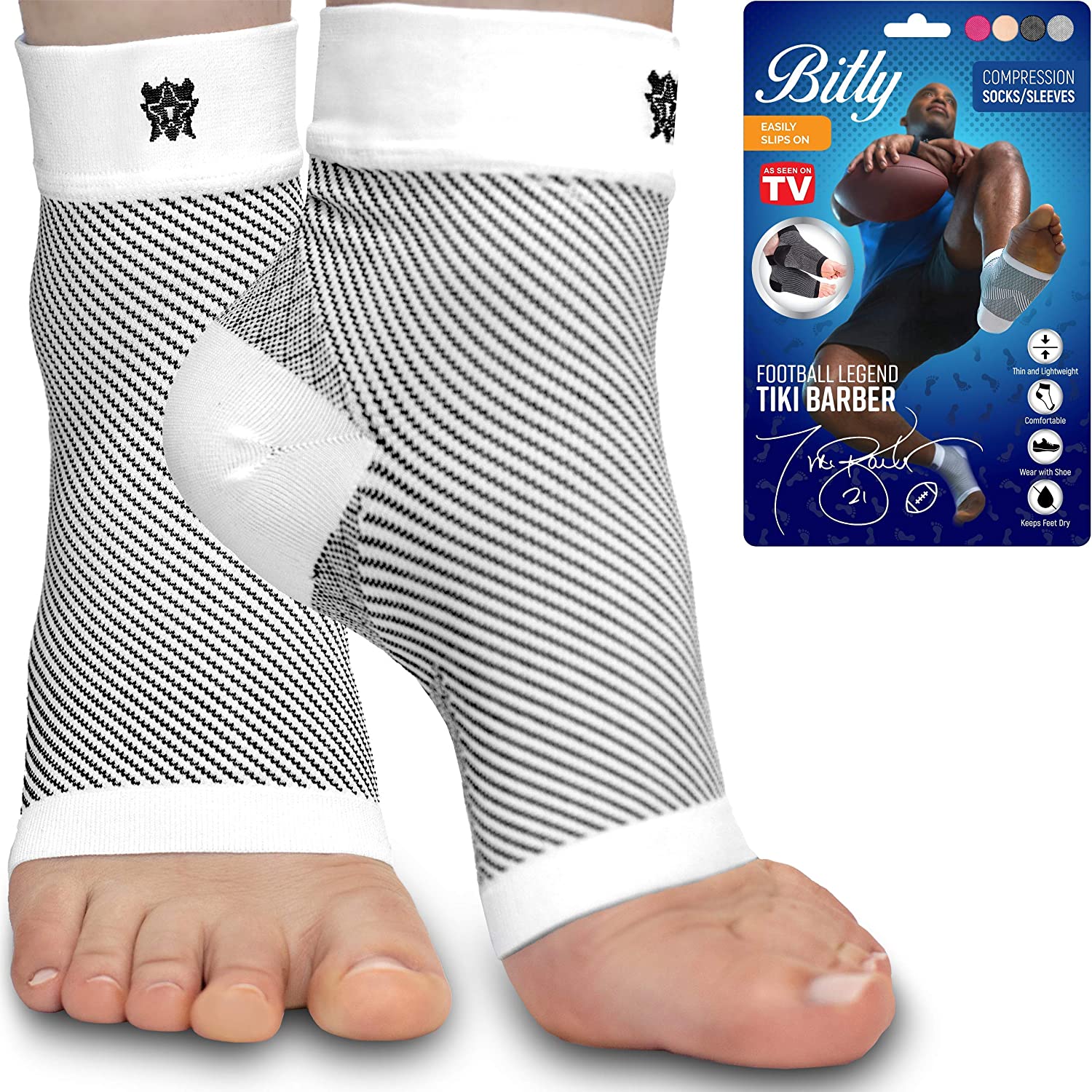
Editor’s Rating:
Quick Facts
Textile: Thin and lightweight fabrics
Compression Level: Graduated compression sock sleeves
Length: Mini ankle sleeves
Review
These socks are made of thin and lightweight fabric that provides ample compression around the ankles, arches, and heels, providing relief from pain to those who suffer from plantar fasciitis. It provides graduated compression with maximum support for the heel that prevents inflammation in the plantar fascia which leads to reduced pain in the heels.
These socks are perfect for people who suffer from pain in this area of the feet as they also prevent further aggravation and injury to the musculature in this area.
While the initial design was in the form of socks, the brand has changed it to mini ankle sleeves which can be worn along with regular socks. They’re available in four standard sizes and you might not find one that’s a perfect fit for your feet.
Another minor complaint is the limited variety of colors offered. Even though you can wear them on their own, it would lead to stinky feet – so these sleeves can’t be worn without socks unless you’re lounging at home.
- Lightweight and breathable fabric
- Can be worn with other socks
- Excellent pain relief and pain reduction
- Best heel support
- Reduced heel inflammation
- Limited colors and sizes on offer
- Some people might simply not find their proper fit
- Need to be coupled with other pairs of socks when worn with shoes.
5. Best Compression Socks for Travel: Laite Hebe
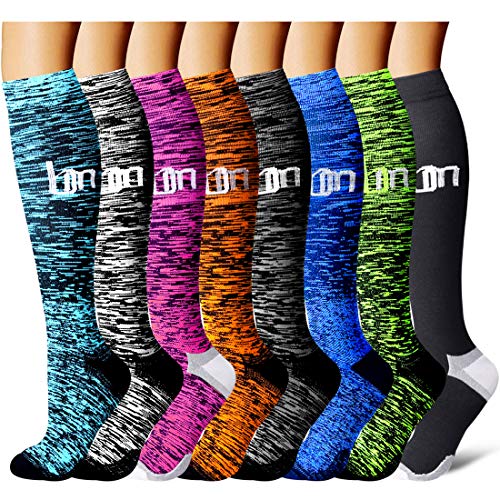
Editor’s Rating:
Quick Facts
Textile: High-performance breathable fabric
Compression Level: 20-30 mmHg
Length: Knee-length
Review
Are you put off by long-distance travel due to swollen and aching feet? Here’s the solution to this specific problem. Laite Hebe makes the best compression socks for traveling long distances without experiencing edema, fluid retention, and aching feet arches and heels.
They apply ample pressure on the calves to regulate blood flow and the feet to keep them from swelling during long durations of inactivity. They also prevent blood clots in the lower legs. Being thick and soft in texture, they also keep your feet warm during those long hours in cold cabins.
Since these socks are designed to promote better blood circulation, you can also wear them to combat swelling and deal with varicose veins even when you aren’t traveling.
On the downside, these socks aren’t made of moisture-wicking fibers so wearing them in warmer seasons and high temperatures isn’t recommended. The top band also seems to be a little problematic to begin with. It’s too tight when you first start using it but gets better with each use until it starts rolling down the leg which creates other problems.
- Keep your feet warm and toasty over long-distance travel
- Promote better blood circulation to avoid clots, inflammation, and pain
- Extra support for foot arches and ankles
- The top band starts pinching after long periods
- Socks keep rolling down during strenuous athletic activities
- No moisture-wicking
- Slight odor build-up
6. Best Premium Compression Socks: FuelMeFoot Copper
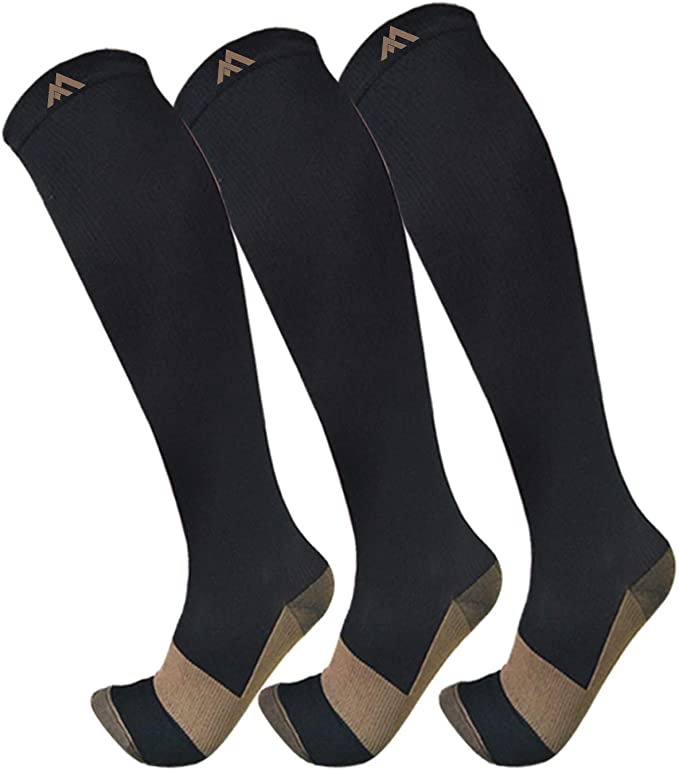
Editor’s Rating:
Quick Facts
Textile: 5% Copper ion fibers, Spandex/Elastic, Nylon
Compression Level: 15-20 mmHg, graduated compression socks
Length: Knee-length
Review
Copper is known to be good for the body and is worn as a metallic bangle in a lot of Asian cultures. These compression socks by FuelMeFoot are reinforced with 5% copper ion fibers that promote blood circulation, prevent pooling and clotting of blood, and protect legs and feet from problems related to poor circulation like DVT, varicose veins, swollen feet, and pain in the arches and ankles.
These mild compression level socks are really good for light physical activities like walking, short runs, and jobs that do not require you to be on your feet all day long.
Having said that, here’s what an expert thinks about the inclusion of copper in compression socks. Although people have reported improved and additional benefits owing to copper, it could be a placebo effect. On the other hand, there’s age-old wisdom from the east that vouches for the benefits of wearing copper. This is just a disclaimer, and you are the best judge of what you want to believe.
Coming back to the socks, although the pack boasts of cuffs that stay firmly in place, they don’t, instead, they tend to slip downwards by the end of the day. The fabric reduces moisture build-up and the copper ensures that there’s no odor as it is a natural antibacterial metal. Fit-wise they don’t adhere to standard sizes and run a little small.
- Copper ions rejuvenate blood circulation
- Reduction in blood clots
- Excellent for alleviating DVT
- Eases pain and swelling
- Moisture-wicking fabric – keeps your feet dry
- Socks aren’t standard sized running into fit issues
- The top cuff keeps rolling down
- Not everyone is convinced copper helps at all
7. ACTINPUT
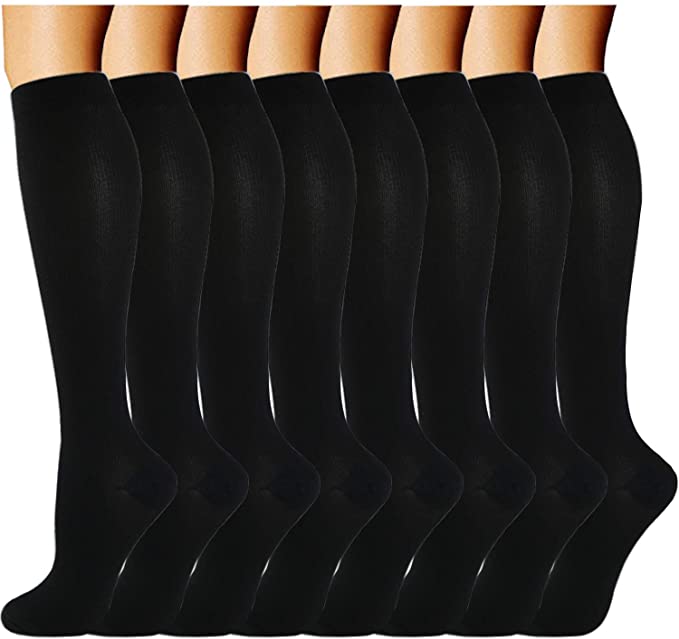
Editor’s Rating:
Quick Facts
Textile: 85% Nylon, 10% Polyester, 5% Elastane
Compression Level: 15-20 mmHg
Length: Knee-length
Review
These compression socks are almost like thick stockings that fit very snugly and provide enhanced calves support in addition to proper compression. The elastane ensures that they fit snugly regardless of the size and girth of your legs.
This results in good blood circulation even after 14 hours of wearing the socks – no more swollen feet, no more pooling of blood or formation of blood clots, no more painful and fatigued feet at the end of the day. You stay comfortable and light on your feet as they stay dry, comfortable, warm, and snugly enclosed in the warmth of these mild-grade compression socks.
Each pack contains 8 pairs of socks which work out to less than $4 per pair of socks, very cheap if you ask us. On the flip side, these aren’t the most durable pairs and the elasticity suffers after a few washes.
- 26 different color sets to choose from
- Can be worn all day long without any discomfort
- Best compressions socks for swelling reduction
- Thick and stretchy like stockings
- Not lightweight for socks
- Not durable
8. Best for Relief from Swelling: BLITZU
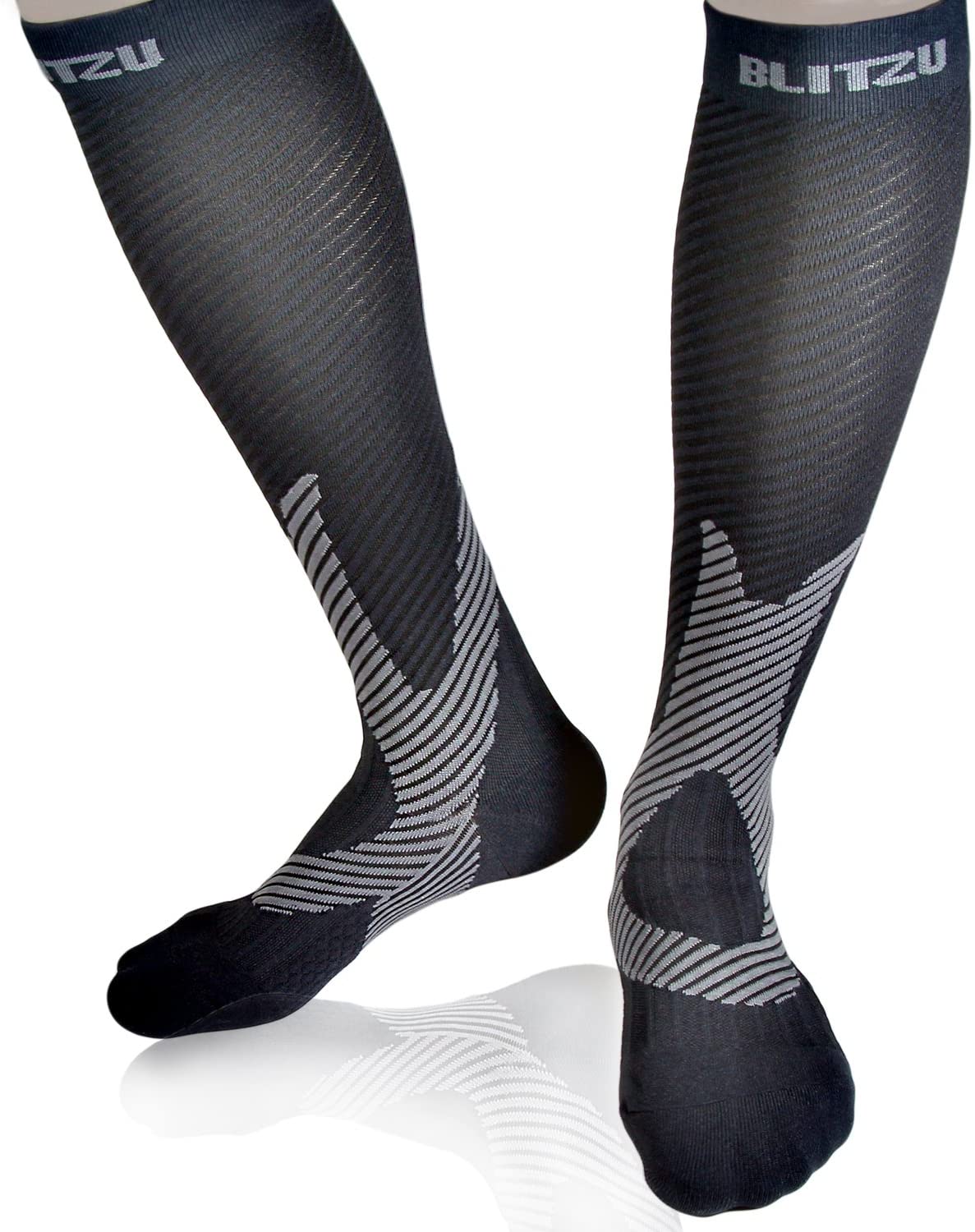
Editor’s Rating:
Quick Facts
Textile: Power+ premium performance fabric
Compression Level: 20-30 mmHg, graduated compression socks
Length: Knee-length
Review
These socks incorporate the principles of body movement in their design aesthetic, thereby making them much more advanced than regular compression socks.
The ribbed and twilled design provides stability to the arches resulting in reduced swelling and relief from pain. Extra support and compression around the heel ensure that existing problems with inflammation are addressed and heal over time.
Not only do these socks provide the benefits of compression socks all day long, but they also promote healing and reduce the prevalence of problems related to swelling. The design also makes the toes seamless to avoid irritation and bumps around the toes. The quality of the materials used is excellent and the fit smooth and snug.
These socks run a size small than standard knee-length socks so you might not get the right fit if you order your regular size. Another issue is with the quality of stitching and durability. The stitching seems to come apart within a few washes, rendering the socks kind of useless. When contacted with these issues, the brand doesn’t respond in time, or indeed, at all.
- The design incorporates principles of kinesiology
- Vertically ribbed socks stabilize the foot arches
- Kinesiology compliant design stabilizes the Achilles tendon preventing swelling in heels and ankles.
- Seamless toes design to avoid toe discomfort
- Poor customer support when contacted with durability issues
- Sizes run small leading to issues with length and fitting
- Not very durable
9. Iseasoo Copper Knee High
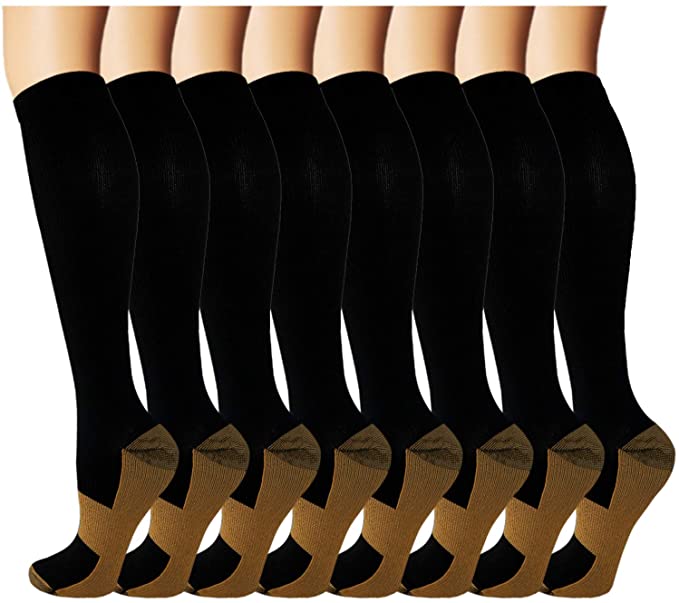
Editor’s Rating:
Quick Facts
Textile: Cotton, Copper fibers
Compression Level: 15 – 20 mmHg
Length: Knee-length, Ankle-length
Review
Iseasoo compression socks are mainly composed of cotton – a fabric that isn’t as well represented in this list with nylon taking precedence over cotton in most designs. If you’re looking for compression socks that make use of natural fibers and allow your skin to breathe, then these are the socks for you.
Luckily, this design is available in two lengths. You can opt for the length that answers to your needs – full lower leg compression and support or you can get support for heels and arches only with their ankle-length option.
The advantage of wearing cotton socks is it allows your skin to breathe, which means you don’t sweat as easily and thus avoid moisture and odors naturally. Copper is also an antibacterial agent, so it also aids in keeping the bad odors away.
Since these socks do not offer graduated compression, it means that even though the compression level is mild, they tend to be too tight around the toe area. Also, the material doesn’t hold for long and starts deteriorating after a couple of washes. Even if the price per pair works out to be really cheap, in the long term, the cost of buying new pairs adds up.
- Made of breathable ventilated mesh cotton fabric
- Wide variety of colors to choose from
- Available in two different lengths – ‘Knee-length’ and ‘Ankle-length’
- Infused with copper fibers along with natural cotton fibers
- Too tight around the toes
- Not durable
10. Vitalsox Silver Drystat Patented Athletic Graduated
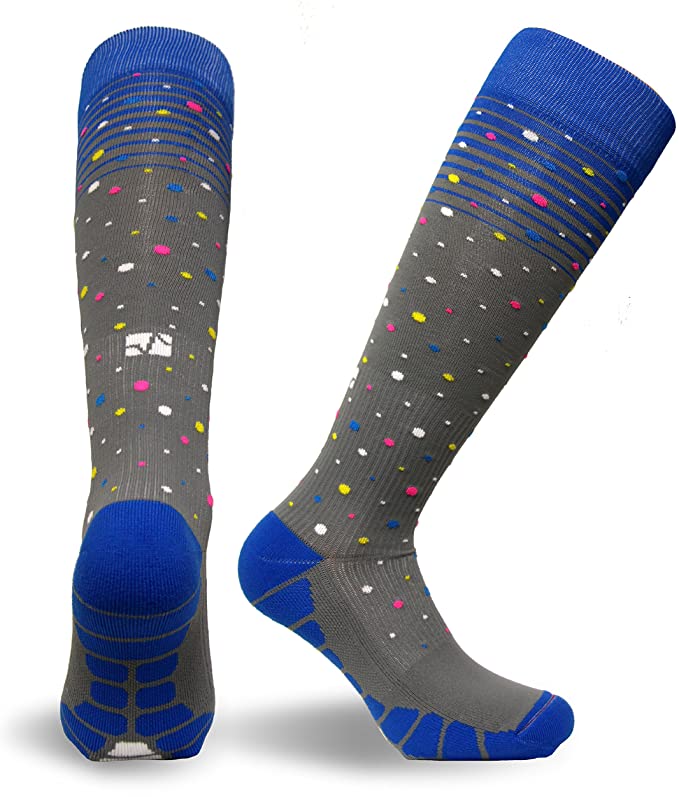
Editor’s Rating:
Quick Facts
Textile: Silver Drystat, Spandex, Lycra,
Compression Level: Varies with different designs
Length: Standard
Review
Unlike the other compression socks featured in the list above, Vitalsox offers different compression socks to address different needs. You can choose the right socks for your need by looking through their codes – like this one that’s adapted for enhanced athletic performance has the code VT1211, the one designed for shorter legs goes by the code VTW0316, and so on.
They also use a patented technology that incorporates silver fibers in the socks which prevent the growth of bacteria, fungus, and consequently bad odors in the socks. The socks are very stretchy and provide a very tight fit. Even though the cuff at the top looks like it might cut-off your circulation, the socks offer graduated compression and the cuff is quite comfortable for long-duration wear. The socks are thick, warm, and can be worn comfortably for long durations.
- Silver Drystat technology used to repel bacteria, fungus, and bad odors
- Different designs for different needs
- Snug fit with graduated compression that varies with different designs
- There’s no standard grade of compression followed
- Finding your size requires a trial run and multiple orders
- Your mileage may vary according to your expectations – too tight or not tight enough
Honorable Mentions
In addition to these ten, there are a few up and coming brands as well as unique offerings that you should be aware of:
- If you live in cold climates, you might want to check out these compression socks made of merino wool fibers – CEP Men’s Winter Ski Merino Compression Socks. As expected, they are eye-wateringly expensive owing to the use of Merino wool.
- If you would like to splurge on a pair of expensive compression socks made with regular fibers, have a look at this pair designed by Zensah Tech+.
- Lastly, here’s an up and coming brand that isn’t very well known yet but offers an exquisitely designed pair of compression socks that are quickly gaining in popularity – Sockwell Men’s Circulator Moderate Graduated Compression Socks.
To learn more about the science behind compression socks, their benefits, the different levels of compression, and more, keep reading.
Frequently Asked Questions
What Is MmHg?
It’s a manometric unit of pressure measured in terms of millimeters of mercury, mm – millimeter, Hg – mercury.
Are There Any Side Effects of Wearing Compression Socks?
Although compression socks can be worn without a medical prescription and are generally safe to use by everyone, people with pre-existing conditions like skin allergies, problems with the vascular system, ulcers, and so on might experience adverse reactions like aggravated venous insufficiencies, blisters, more pronounced pain, and so on.
It’s always best to consult a doctor if you are unsure of your condition. Wearing the wrong kind of compression socks for your legs might introduce new problems where there were none.
What Is Graduated Compression?
Graduated compression is different levels of compression or pressure at different points – lesser compression around the cuff and calves, increased compression around the ankle, reinforced arch support, and less compression around the toes.
Most graduated compression socks have compression build-up around the mid-foot, it keeps increasing until the socks reach the ankles, after which it starts decreasing gradually. Non-medical compression socks are mostly designed to improve ease of mobility, boost blood circulation, prevent swelling, and aid in relief from pain and fatigue.
Are These Commercially Available Socks the Same as Medical-Grade Compression Socks?
No. These socks usually provide mild to firm compression ranging from 15 mmHg to 30 mmHg and do not require a prescription from a medical practitioner.
Medical grade compression socks are specifically fitted to the patient, require an Rx, and are designed to address chronic venous and inflammatory problems. Although brands like to mention stuff like ‘as good as medical-grade compression socks’, it isn’t completely true.
What’s the Science Behind the Working of Compression Socks?
Compression socks apply extra pressure along various points on your feet and legs which results in:
- constricting the radius of the veins that supply blood to the legs which improves the velocity of the blood in both directions – to and from the heart
- increases the volume of blood pumped in each cycle – leading to better circulation
- better blood flow with the improved upward flow of blood to the heart
- prevention of blood pooling – i.e., collecting and clotting of blood in the veins of the lower legs and feet
What Are the Different Levels of Compression?
As mentioned above, there are different ranges of compression that these socks are available in. Below, we mention the reasoning behind using these standard levels of compression and how they impact our feet.
8 -15 mmHg
These fit a little more snugly than regular socks. You can put them on easily and feel almost no pressure after a while. If you suffer from pain and fatigue after a long day, this level of pressure is enough for you to combat the tiredness and pain. This level of pressure will also improve circulation and prevent minor cases of swollen feet.
15-20 mmHg
These mild compression socks can deal with swelling, varicose veins, and aid in DVT inhibition. If your job involves being on your feet all day or long-distance travel, this is the ideal compression grade for you. Basically, if your feet don’t move a lot for a long time, whether you are standing or sitting, then you should go for mild compression socks.
20-30 mmHg
These are best suited to those who have varicose veins or spider veins. This level of compression can combat edema or swelling, DVT, provide relief from pain and tired feet. This is Class I Compression and is best suited for those who already have problems with their feet.
They are also prescribed for people who are very active in sports, gyms, and other athletic pursuits. They boost blood circulation, improve lymphatic drainage, and protect feet from pain and injuries when you are on the move for extended periods.
30-40 mmHg
This is also known as Class II Compression. This level is usually reserved for the treatment of severe and chronic conditions and often requires a doctor’s prescription. Commercially available compression socks rarely offer this level of compression.
40-50 mmHg
Known as Class III Compression, this is the highest grade of compression. Only medical-grade socks offer this level of compression and they are out of the purview of this guide.
Benefits of Compression Socks
Here’s a quick list of all the benefits you can derive from wearing compression socks:
- Improved blood circulation in your legs
- Promote better lymphatic drainage
- Additional support for your veins
- Prevent pooling and clotting of blood in the lower legs
- Inhibit the development of DVT
- Reduced swelling
- Reduced pain due to swelling, venous thrombosis, and other inflammatory problems
- Reduced pressure on the veins in the lower legs resulting in the prevention of the onset of the resultant problems
Pro Tips for Making the Best Use of Compression Socks
In order to get the best out of your compression socks, keep the following tips in mind:
- Your feet and their associated problems are unique to you. So, read up about the problems you need to tackle and order a pair of compression socks that address your issues specifically. Say you suffer from pain in the ankles and swollen feet, then you should look for socks that are designed to address these problems specifically rather than going with the best compression socks overall or the most expensive pair available. The one size fits all approach will not help you.
- Different brands have different sizes, even if the socks themselves are advertised as regular or standard length. An inch here or there will be the difference between a comfortable cuff vs. one that keeps rolling down and bunching. Some brands run large, while others run smaller than the standard size. Always order two different sizes, you can send one back and keep the ones that fit better. You might miss out on the perfect socks for you simply because you ordered the wrong size. This might seem like a tedious process, but it’s very important that you wear the right size and fit for your legs to apply pressure at the right places. Otherwise, it beats the purpose of wearing compression socks.
- Since most compression socks have maximum pressure at the ankle, a good rule of thumb is to order compression socks by ankle size. Most brands mention the dimensions online. You can simply refer to these charts to make a good approximation as to what size would be the best fit for your feet.
- Most compression socks are difficult to put on and take off, and this is by design. Don’t discard a pair just because the cuff looks too tight, or you simply couldn’t spare the time to put them on regularly.
- Compression socks should never be put in the drier. Always wash them gently and air dry them to get maximum durability.
- If you notice any adverse effects from wearing compression socks, like new pain points, swelling or bumps in places where there were none, blisters or breakouts, stop wearing the socks and consult a physician.
- Unless prescribed by a doctor or directed by a physiotherapist, do not wear your compression socks to bed. Very few compression accessories are designed to be worn during sleep cycles as you run the risk of cutting off blood supply to your extremities.
- If you aren’t sure about how long you can wear your socks, read the instructions on the package, reviews online, and make a note of the time when the socks start getting uncomfortable. Based on your research and observations, you should arrive at the number of hours that your feet agree with for wearing compression socks.
- Compression socks are safe for use by all genders and ages. And more often than not, they’re unisex. There’s no special design that can improve performance for one gender without doing the same for the other.
Final Thoughts
Compression therapy should be your first line of defense against problems related to your feet. Before you opt for expensive orthopedic procedures, try compression socks to see if you can arrest and reverse these problems before they become chronic.
So, whether you are at work, in the gym, out hiking, trekking, exploring nature with your family, or just lounging at home, compression socks can make your life so much better by improving the circulation in your lower legs, avoiding complications like swelling, pain in the arches and heels, tired feet, and addressing chronic problems resulting from faulty veins and improper lymphatic drainage.
You can choose different grades of compression for different activities and give yourself the health boost required to enjoy every occasion properly without succumbing to problems related to your feet. Enjoy browsing our guide for the best compression socks for you.
